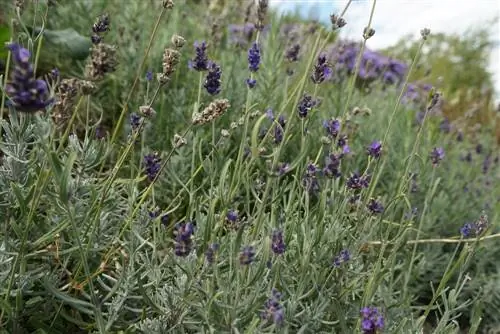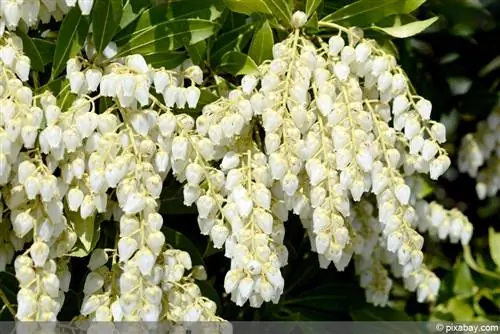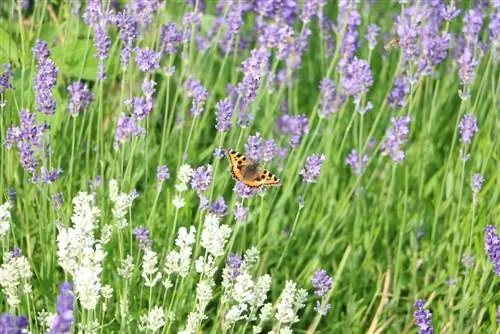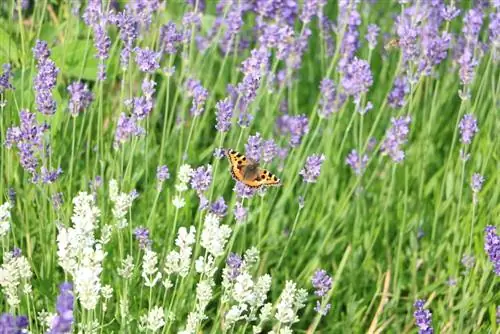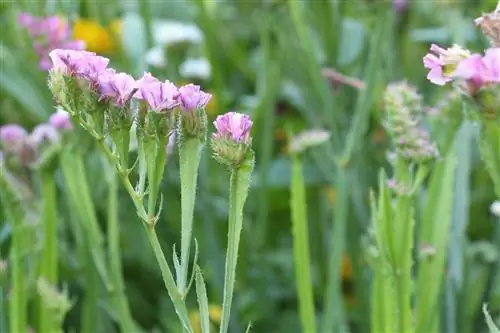- Author admin [email protected].
- Public 2023-12-17 03:39.
- Last modified 2025-01-24 12:45.
Lavender with its aromatic scent is welcome in every garden in this country. Real lavender is quite hardy in our latitudes. With proper care and location, it grows into large bushes.
Profile
The real lavender (Lavandula angustifolia) originally comes from areas in the Mediterranean region. Due to the essential oils they contain, the easy-care subshrubs exude a very pleasant, sweet scent during the summer months. In addition to real lavender, there are now up to 30 other varieties of the popular spice and medicinal herb. However, these are not as hardy as Lavandula angustifolia. However, the following are typical for real lavender:
- Growth height 50 to 100 cm
- intense blue-violet flowers
- many individual flowers standing together in spikes
- tomentose hairy gray-green to silver-colored leaves
- Belonging to the mint family (Lamiaceae)
- woody from below
- can therefore cope well with drought and high temperatures
- undemanding in care
- also good to cultivate in pots
- good beginner plant
Note:
Lavender regulates digestion and calms the nerves. As a bath additive, the herb has a blood pressure regulating and skin care effect.
Location
Growing lavender is quite easy. However, for he althy growth, some requirements must be met. Lavender places certain demands on its location. The subshrub originally comes from the dry areas of the Mediterranean and grows there on rather poor and stony soils. In this country, too, Lavandula angustifolia needs similar conditions to thrive. He needs
- a sunny, dry and wind-protected place
- lean, permeable, calcareous to neutral soil
- prepare heavy soils with sand
A slightly sandy to stony planting substrate is ideal when cultivating the subshrub, as the drought-loving lavender cannot tolerate waterlogging.
Plants

The uses of Lavandula angustifolia in the garden are quite diverse. It can easily be planted out in a bed, but it can also be cultivated in a bucket or pot. This has the advantage that the lavender can also exude its aromatic scent in a wide variety of places such as balconies and terraces. This subshrub is also often used to create low hedges. Three plants should then be planted here per running meter. When planting outdoors, proceed as follows:
- best time spring from mid-May
- Dig planting hole
- twice the size of the root ball
- Insert drainage layer in planting hole
- consisting of pebbles and sand
- Insert plant in the middle
- Fill up calcareous, loose soil
- Press well and pour in
- Planting distance must be at least 30 cm
- This enables good bushy growth
In the garden, Lavandula angustifolia can also be easily integrated into a herb spiral. Here the subshrub should find its place in the upper third in a south or west direction.
Bucket Culture
Lavender also looks good in an appropriately large pot on the balcony and terrace. The following must be taken into account when growing these sub-shrubs:
- Pot must have a drainage hole at the bottom
- A coaster is also important
- Clay pots are well suited
- better evaporation of the water possible here
- Insert drainage layer in pot
- consisting of pebbles, expanded clay or pottery shards
- apply a nutrient-poor, calcareous substrate layer on top
- preferably use herbal soil mixed with sand
- Insert plant
- fill remaining soil
- press firmly and pour in
Transplanting
If possible, Lavandula angustifolia should not be transplanted when grown outdoors. Over the years it develops a widely branched and deep network of roots. In an ideal location it can live to be 15 years or older. However, if transplanting is necessary, proceed as follows:
- loosen roots in a large and deep manner with a digging fork
- then carefully dig it out
- Don’t hurt roots
- plant again in another location
- best time March to May
Repotting
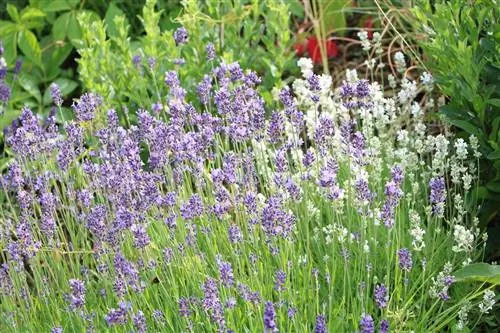
When growing in a bucket or pot, repotting should be done annually if possible. The best time is March before the new shoots:
- Choose a new bucket at least a third larger
- replace old substrate completely with new one
- ideally a third of compost mixed with coarse, calcareous sand
- Carefully loosen the root ball before reinserting it
- possibly cut back roots a little
Note:
When it comes to real lavender, the varieties “Peter Pan” and “Nana Alba” are particularly suitable for growing in pots. In addition, varieties that are not as hardy as lavender (Lavandula stoechas) or lavender (Lavandula latifolia) are also recommended for cultivation in pots.
Plant Neighbors
Lavender naturally feels particularly at home among its peers in the bed or in the herb spiral. In other words, this includes other Mediterranean herbs that have exactly the same requirements for location and soil as the subshrub. These include, among other things,
- Sage (Salvia)
- Thyme (thymus)
- Rosemary (Rosmarinus officinalis) or
- Mountain savory (Satureja montana)
Lavender is often said to be a good companion for roses (pink). He is supposed to check the aphid infestation on roses. reduce. However, you should avoid growing the subshrub in the immediate vicinity of roses because the demands on the soil are too different here. In contrast to lavender, the queen of flowers prefers humus and nutrient-rich soil. Catnip (Nepeta cataria) is more suitable as a plant neighbor here. However, you don't have to completely avoid lavender in the rose bed. However, this should then be planted at a minimum distance of 80 to 100 cm. Sand must then be filled into the planting hole.
Pouring
When growing Lavandula angustifolia, care is of course always crucial for he althy growth. Lavender has a widespread root system with a long taproot. This means that the subshrub is able to supply itself with nutrients and the moisture it needs from the deepest layers of the earth. Normally, Lavandula angustifolia only needs additional watering in the garden during long dry periods. Things are different with pot culture. A regular water supply is important here. However, the surface of the soil should be dry before watering again.
Generally, watering is done as follows:
- Always water only close to the ground
- Do not wet leaves and flowers
- otherwise fungal infestation possible
- always water in the morning
- Plant can then dry well during the day
Note: Lavender is not only something for the eye, but it also magically attracts beneficial insects such as bees, bumblebees and butterflies.
Fertilize
Fertilizing should not be forgotten when growing Lavandula angustifolia, but it should be done carefully. The subshrub only needs a few nutrients. Over-fertilization through regular nutrient additions would be more damaging to the subshrub. He would inevitably die. Some organic fertilizer or compost should be incorporated into the soil when planting. In such a case, basic fertilization is only necessary again the following year in March/April. Fertilizer is only added again at the beginning of summer if the culture is grown in a bucket. However, when growing real lavender, it is advisable to add a little garden lime in the spring:
- spread a handful of lime around plants
- Work in lightly with a rake
- Soil pH value should be between 6, 5 and 8
- Measurement required
Cutting
Over time, the young shoots become woody from below. Pruning is therefore necessary to prevent baldness. One or two prunings should therefore be carried out every year:
- first pruning in spring shortly before new growth in March/April
- cut back here heavily
- Short the plant by at least one to two thirds
- second pruning after flowering July to early August
- only shorten older plants by a third
- You can cut back up to half of younger plants
Note:
No pruning should be done in autumn, otherwise there could be severe frost damage and no flowers next year.
Flowering time
The flowering time always depends on the variety, the weather, the soil conditions and care. Flowering for Lavandula angustifolia begins in June to the end of July / beginning of August. On the other hand, the first flowers of lavender are visible from May onwards. Summer pruning can stimulate renewed flowering.
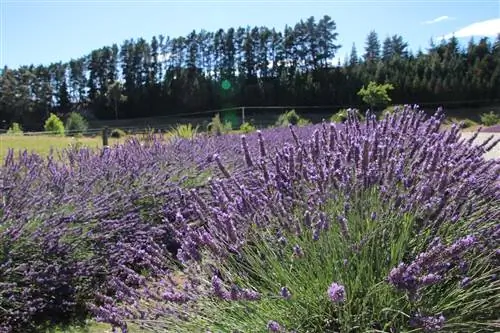
Harvest time
Lavender leaves and flowers are edible. They can be used in salads, soups or fish dishes. Harvesting should take place shortly after the flowers open in May/June to August/September. Flowers, leaves and young shoot tips are harvested.
Wintering
Lavandula angustifolia is hardy down to temperatures of -15°C. Nevertheless, light winter protection should also be provided outdoors, especially to prevent frost drying:
- apply a layer of leaves or brushwood to the root disc
- possibly cover the plant with fleece or coconut mats
- Winter non-hardy varieties or potted plants in a bright, frost-free and cool place in the house
- If necessary, water plants on frost-free days
Propagate
Propagation can be done by sowing, planting and cuttings. The latter method is the easiest and fastest:
- Cut 15 cm long cuttings in spring or late summer
- strip off the lowest leaves
- then insert 10 cm deep into a mixture of sand and potting soil
- keep well moist
- single after root formation
- plant outdoors after the last frosts
Sowing
- Pre-culture February to May on windowsill
- Use of sowing soil
- Press seeds lightly onto moist soil
- Plant is light germinator
- set up bright and warm
- keep well moist
- The first seedlings appear after 10 to 20 days
- separate if large enough
- Direct sowing possible from May
Lowers
- In spring, press the branch to the ground and remove the leaves
- draw a furrow underneath it
- Introduce the branch there and cover it with soil
- fix well with wire
- Root formation takes place by autumn
- then separate the young plant from the mother plant
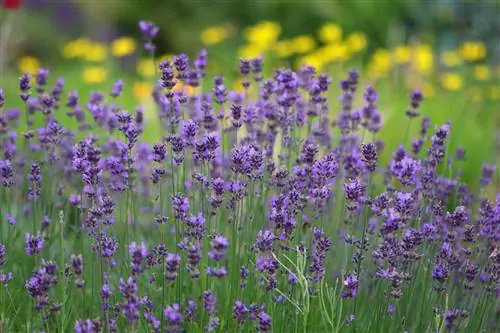
Diseases and pests
Due to the essential oils it contains, Lavandula angustifolia is rarely attacked by pests. However, there are also diseases here that are feared:
Root rot
- especially occurring in warm winters and in high humidity
- The roots die off due to waterlogging
- This means that the plant no longer has any water supply
- eventually dries up
- remove or repot diseased plants
- Avoid waterlogging
Phoma Lavandulae
This is a fungal disease. The infection occurs through wounds and during the summer months it also occurs on young shoots in the leaf axils. The fungus spreads within the plants:
- Emergence of yellowish branches in May
- Plant next to it covered with brown-black spots, especially leaves
- there formation of spherical fruiting bodies of the mushrooms
- Eventually the affected parts of the plant die off
- remove diseased plant parts immediately and dispose of them in household waste
- possibly also complete plant


